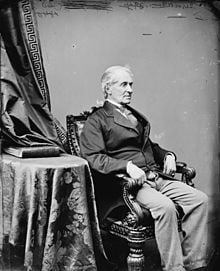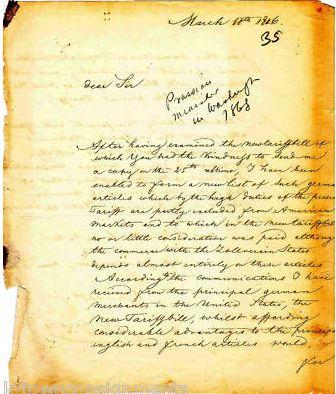Longest-serving Ambassador of Germany in the USA
Longest-serving Ambassador of Germany in the USA

I was able to get a great historical document of German-American relationships. The letter is handwritten by Friedrich von Gerolt in the 1840s.
Friedrich Karl Joseph Freiherr von Gerolt (5 March 1797 Bonn – 27 July 1879 Linz am Rhein) was Prussian Privy Councillor, Envoy Extraordinary and Minister Plenipotentiary in the United States.
Gerolt was consistently 27 years as a diplomat in the United States and is still regarded as the longest-serving ambassador of Germany in the USA.
During his time in Washington, he maintained useful contacts with many politicians, including several presidents and government ministers.
In the quarter-century of service, Gerolt saw Presidents James K. Polk, Zachary Taylor, Millard Fillmore, Franklin Pierce, James Buchanan, Abraham Lincoln, Andrew Johnson, and Ulysses Grant.
Millard Fillmore was the only incumbent U.S. president, who visited Germany in the 19th century. In 1855, he met with Alexander von Humboldt and King Friedrich Wilhelm IV together in Berlin. In this period 1.5 million German emigrated to the U.S., and there were a total of 14 German consulates in New York, Philadelphia, Baltimore, Charleston, New Orleans, St. Louis, Galveston, Savannah, Cincinnati, San Francisco, Louisville, Milwaukee, Chicago, Boston, and New Bedford.

He studied mining and geology in 1823 and was listed as a Mining Office secretary in Düren. In March 1824, he traveled to Mexico, prospecting for silver mines, and published a geological map in 1828. King Friedrich Wilhelm III invested him and his brothers in 1830, with the Leyen manor (now Castle Ockenfels in Ockenfels).
In 1837, he was charge d’affaires in Mexico and, at the suggestion of Alexander von Humboldt in 1844, made Extraordinary Envoy and Minister of the Kingdom of Prussia to the United States of America. In October 1848, he was superseded by Friedrich Ludwig von Rönne. He sought to comment on a German constitution from John C. Calhoun. From 1849 to 1868, he was again sent as an ambassador of Prussia to Washington from 1868 until the empire was founded in 1871, he was then working for the North German Confederation as an envoy in Washington.
In 1852, he negotiated an extradition treaty with Daniel Webster. In 1858, Gerolt was elevated to Freiherr. Alexander von Humboldt was Gerolt’s protegee and introduced him in 1844 to King Friedrich Wilhelm III – then his outstanding career began. Currently, I try to read and understand the content of the letter. Longest-serving Ambassador of Germany in the USA
FAQ Passport History
Passport collection, passport renewal, old passports for sale, vintage passport, emergency passport renewal, same day passport, passport application, pasaporte passeport паспорт 护照 パスポート جواز سفر पासपोर्ट
1. What are the earliest known examples of passports, and how have they evolved?
The word "passport" came up only in the mid 15th Century. Before that, such documents were safe conducts, recommendations or protection letters. On a practical aspect, the earliest passport I have seen was from the mid 16th Century. Read more...
2. Are there any notable historical figures or personalities whose passports are highly sought after by collectors?
Every collector is doing well to define his collection focus, and yes, there are collectors looking for Celebrity passports and travel documents of historical figures like Winston Churchill, Brothers Grimm, Johann Wolfgang von Goethe. Read more...
3. How did passport designs and security features change throughout different periods in history, and what impact did these changes have on forgery prevention?
"Passports" before the 18th Century had a pure functional character. Security features were, in the best case, a watermark and a wax seal. Forgery, back then, was not an issue like it is nowadays. Only from the 1980s on, security features became a thing. A state-of-the-art passport nowadays has dozens of security features - visible and invisible. Some are known only by the security document printer itself. Read more...
4. What are some of the rarest and most valuable historical passports that have ever been sold or auctioned?
Lou Gehrig, Victor Tsoi, Marilyn Monroe, James Joyce, and Albert Einstein when it comes to the most expensive ones. Read more...
5. How do diplomatic passports differ from regular passports, and what makes them significant to collectors?
Such documents were often held by officials in high ranks, like ambassadors, consuls or special envoys. Furthermore, these travel documents are often frequently traveled. Hence, they hold a tapestry of stamps or visas. Partly from unusual places.
6. Can you provide insights into the stories behind specific historical passports that offer unique insights into past travel and migration trends?
A passport tells the story of its bearer and these stories can be everything - surprising, sad, vivid. Isabella Bird and her travels (1831-1904) or Mary Kingsley, a fearless Lady explorer.
7. What role did passports play during significant historical events, such as wartime travel restrictions or international treaties?
During war, a passport could have been a matter of life or death. Especially, when we are looking into WWII and the Holocaust. And yes, during that time, passports and similar documents were often forged to escape and save lives. Example...
8. How has the emergence of digital passports and biometric identification impacted the world of passport collecting?
Current modern passports having now often a sparkling, flashy design. This has mainly two reasons. 1. Improved security and 2. Displaying a countries' heritage, icons, and important figures or achievements. I can fully understand that those modern documents are wanted, especially by younger collectors.
9. Are there any specialized collections of passports, such as those from a specific country, era, or distinguished individuals?
Yes, the University of Western Sidney Library has e.g. a passport collection of the former prime minister Hon Edward Gough Whitlam and his wife Margaret. They are all diplomatic passports and I had the pleasure to apprise them. I hold e.g. a collection of almost all types of the German Empire passports (only 2 types are still missing). Also, my East German passport collection is quite extensive with pretty rare passport types.
10. Where can passport collectors find reliable resources and reputable sellers to expand their collection and learn more about passport history?
A good start is eBay, Delcampe, flea markets, garage or estate sales. The more significant travel documents you probably find at the classic auction houses. Sometimes I also offer documents from my archive/collection. See offers... As you are already here, you surely found a great source on the topic 😉
Other great sources are: Scottish Passports, The Nansen passport, The secret lives of diplomatic couriers
11. Is vintage passport collecting legal? What are the regulations and considerations collectors should know when acquiring historical passports?
First, it's important to stress that each country has its own laws when it comes to passports. Collecting old vintage passports for historical or educational reasons is safe and legal, or at least tolerated. More details on the legal aspects are here...
Does this article spark your curiosity about passport collecting and the history of passports? With this valuable information, you have a good basis to start your own passport collection.
Question? Contact me...

